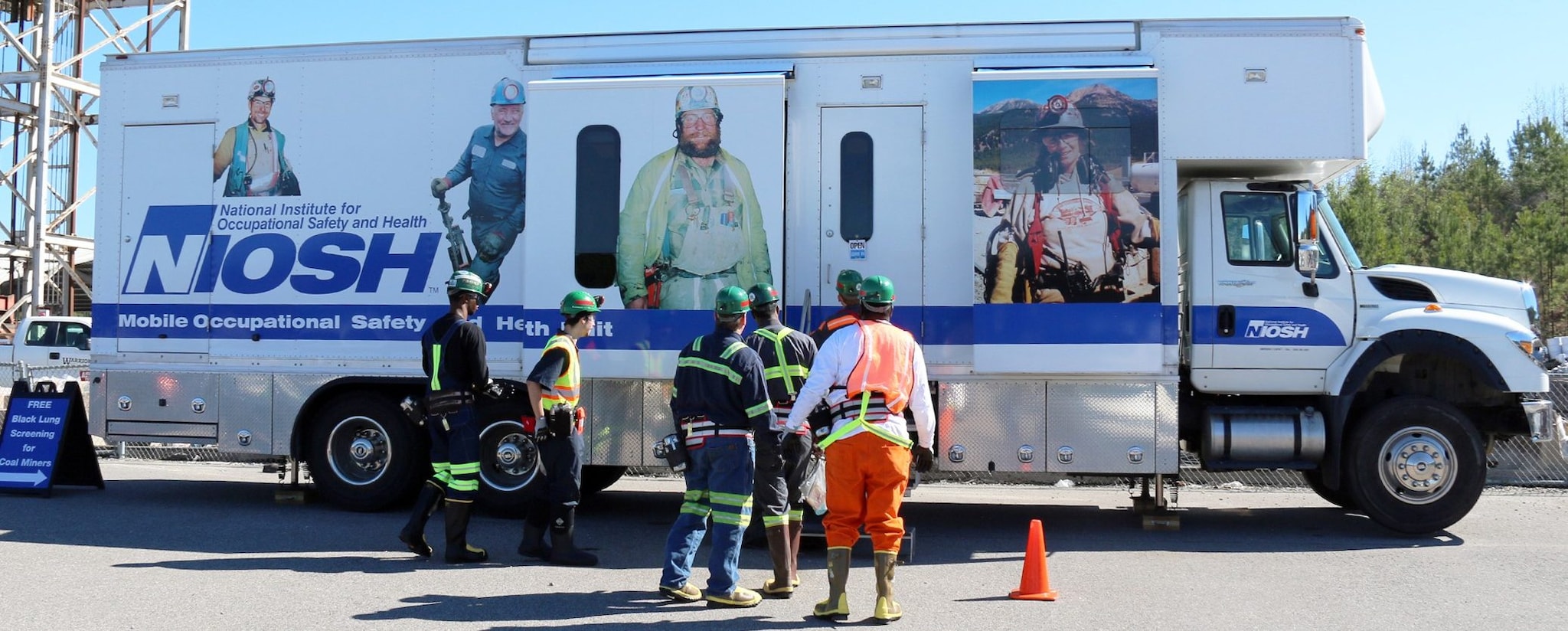Coal Workers’ Health Surveillance Program

Photo by NIOSH
The NIOSH Coal Workers’ Health Surveillance Program (CWHSP) was established by the Federal Coal Mine Health and Safety Act of 1969 (amended in 1977). The program studies the causes and effects of respiratory diseases related to coal mine dust exposure.
Mobile screenings
Season 2024
April
- Washington Health System Greene
- Tuesday, April 16
- 350 Bonar Avenue, Waynesburg PA 15370
- 8am – 4pm
- MSHA National Mine Health and Safety Academy
- Tuesday April 23 – Thursday, April 25
- 1301 Airport Rd, Beaver, WV 25813
- 8am – 4pm
June
- Pipestem Resort State Park
- Tuesday, June 4 – Thursday, June 6
- 3405 Pipestem Drive, Pipestem, WV 25979
- 8am – 4pm
July
- Mylan Park
- Tuesday, July 23 – Thursday, July 25
- 500 Mylan Park Lane, Morgantown, WV 26501
- 8am – 4pm
- Craig Civic Center
- Tuesday, July 30
- 311 Tunnelton Street, Kingwood, WV 26537
- 8am – 4pm
August
- Wild Things Park
- Monday, August 5
- 1 Washington Federal Way, Washington, PA 15301
- 8am – 4pm
- Wheeling Park
- Tuesday, August 6
- 1801 National Road, Wheeling, WV 26003
- 8am – 4pm
- Holiday Inn Express & Suites
- Wednesday, August 7
- 2035 Southgate Parkway, Cambridge, OH 43725
- 8am – 4pm
- Holiday Inn Express & Suites
- Thursday, August 8
- 1101 Spring St, Zanesville, OH 43701
- 8am – 4pm
September
- Mercer Mall
- Tuesday, September 10
- 261 Mercer Mall Rd, Bluefield, WV 24701
- 8am – 4pm
- Holiday Inn Express & Suites Claypool Hill
- Wednesday, September 11
- 180 Clay Drive, Pounding Mill, VA 24637
- 8am – 4pm
- Southwest Virginia Higher Education Center
- Thursday, September 12
- 1 Partnership Circle, Abingdon, VA 24210
- 8am – 4pm
Screenings include:
- Work history and respiratory health questionnaires
- Chest x-rays
- Lung function testing (spirometry)
- Blood pressure screening
Announcements for black lung screenings are made through NIOSH press releases, Facebook , and Twitter. Announcements are also made through local newspapers and radio stations.
Clinic screenings
Black lung screenings are provided at NIOSH-approved clinics located in mining regions across the U.S. Information about facilities can be found at NIOSH Approved Facility Search and Map.
Coal mining-related respiratory diseases are caused by breathing in coal mine dust.
Pneumoconiosis
Pneumoconiosis refers to scarring of lung tissue when breathing in mineral dusts. The primary types of pneumoconiosis seen in coal miners are coal workers’ pneumoconiosis (also called black lung), silicosis and mixed dust pneumoconiosis. Asbestosis is another type of pneumoconiosis, usually seen in other work settings. For more information on the following lung diseases see Pneumoconiosis.
Chronic Obstructive Pulmonary Disease
Chronic Obstructive Pulmonary Disease (COPD) is a lung disease that can impair movement of air into and out of the lungs. It can also impair the ability of the lungs to take up oxygen and remove carbon dioxide from the body. COPD includes chronic bronchitis and emphysema.
For more information see the CDC COPD web page. To learn about work-related COPD through interviews with a physician and patients diagnosed with the disease see the video Faces of Work-related COPD.
Part 90
The U.S. Department of Labor announced an effort to raise awareness of regulations that give coal miners with development of pneumoconiosis, or black lung, the right to work at a section of a mine with lower levels of dust without having their pay reduced or fearing discrimination or termination. Learn more at Miner Health Matters.
National Autopsy Study
The Mine Safety and Health Act of 1977 authorizes the Department of Health and Human Services to provide coal miner autopsies and to pay for their submission to NIOSH. Please refer to Specification for Medical Examinations of Coal Miners Subpart Autopsies for information on payment for autopsy, autopsy specifications, and procedures for obtaining payment. At this time, funding is not available to pay for autopsies.
Medical records, mine plans, forms
Mining Contacts
Communication Materials
Why Black Lung Screenings are Important for Coal Miners – Infographic (Spanish)
NIOSH Coal Workers’ Health Surveillance Program – Fact Sheet (Spanish)
Black Lung Screenings – Fact Sheet (Spanish)
Publication Search
Search the NIOSHTIC-2 database to find additional occupational and safety health publications on this topic from NIOSH or a NIOSH supported project.
NIOSH Respiratory Disease Division
1000 Frederick Lane, Morgantown, WV 26508
CWHSP@cdc.gov | 1-888-480-4042
